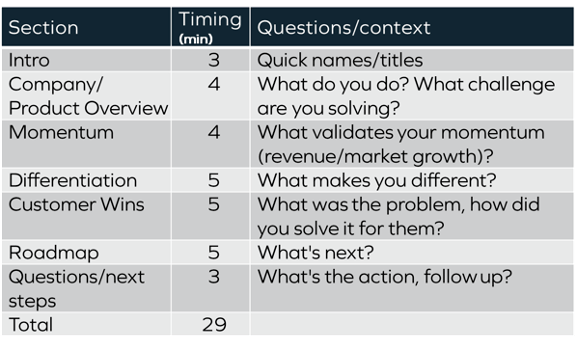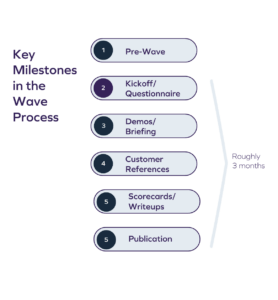Analyst Relations 101: How to Successfully Engage and Brief Analyst Firms

Many ScaleUps think of analyst relations (AR) as a black box. They might know they need to engage with analysts, but they’re not sure how to effectively do it. Other companies ignore AR completely because they don’t understand it. Do this at your peril. Getting featured in an analyst report can unlock major opportunities for SaaS software companies selling into the enterprise.
What is analyst relations (AR)?
Analyst relations is the proactive engagement of analysts at research firms (e.g., Forrester, Gartner, IDC, and others) to develop a mutually beneficial relationship that results in advocacy and market impact. It’s important to note that you don’t need to be a paying customer to brief these firms. In addition to this blog, my colleague Charlene Chen authored our ScaleUp Guide to Analyst Relations which provides context and tactical tips.
After spending six years as a senior analyst at Forrester, I’m excited to share my AR knowledge with Insight’s portfolio and the broader community. While at Forrester, I authored dozens of research reports and conducted five Wave evaluations in the digital experience space, with my most recent Wave published earlier this year on Digital Asset Management (DAM). I saw firsthand what good and bad AR looked like and its rippling effects.
It’s never too early to consider analyst relations
AR is key to scaling a business. It’s never too early to start thinking about and planning an AR strategy. Even for early-stage companies (sub $5 million in revenue), AR can provide powerful benefits. For example, when you brief an analyst for the first time, you have 30 minutes to make this tough audience understand your point of view and make them care. The practice of AR and analyst interactions forces all companies to clearly articulate the market challenge, detail customer pain points, and succinctly describe how their company or product uniquely solves the challenge. To convince the analysts, you must supply evidence in the form of market data and customer case studies. In other words, analyst relations is a form of company branding and product messaging and positioning.
At Insight, I educate our portfolio on the importance of AR: what ScaleUps need to know about engaging with analyst firms, how you can build a briefing deck that catches the eye of the ever-busy analyst, and key insights and tactics to improve positioning. Here are some important key takeaways from these conversations that will help any company with its analyst relations strategy.
Read more: The ScaleUp Guide to Analyst Relations: A Fast Track to Enterprise Credibility
How to build your AR program
The hardest part of getting started is getting started. Many organizations start their AR practices with a marketing professional spending only some of their time on AR. Teams tend to be small. Most Insight portfolio companies have a product marketer carving out a few hours a week to focus on AR, while others may have one or two people dedicated to the practice. For early-stage companies, the founder or CEO owns the AR strategy. It’s only when you move into very large enterprises that full teams of AR professionals are present. Some best practices for developing an AR program include:
Understand the analyst firms and coverage
Gartner, Forrester, and IDC have the broadest coverage of the firms. Even non-clients can search these sites to see topics analysts are covering and some of their recent publication titles or summaries. Do your research to understand which analysts are covering your topic and create a prioritized list of primary and secondary analysts who are related to your space. There are also more specialized firms like Celent and AITE for financial services; KLAS for healthcare; Lux for oil, gas, chemicals, and utilities; and RedMonk for developer-focused companies. These can play an important role in your AR strategy if they’re the right fit.
Think beyond evaluative research
Getting in a Forrester Wave or Gartner Magic Quadrant (MQ) is at the top of most companies’ lists when it comes to analyst relations. But analysts write more than evaluative research. They also write reports on best practices, trends, and predictions. One key series is Gartner’s Cool Vendor reports. Gartner looks for companies that are innovative, intriguing, and impactful; they’re solving problems in new ways. If you catch the eye of Gartner analysts on a briefing, they may nominate you for a Cool Vendor report that publishes in the spring or fall. Your future as a Cool Vendor can be very bright.
Be an endless supply of “grit”
When I was an analyst, every paragraph I wrote needed grit — or evidence. I would often pull from our vast repository of data or look for customer case studies to illustrate a point or key trend. When I needed to dig up new case studies, one of my first stops would be our vendor clients. They had customers who were doing exactly what I was researching. I would conduct a 30-minute interview with them and then use quotes or data, often citing the technology company in the research.
How to brief analysts
The most important piece of information about briefing analysts is that you do not need to be a paying client of the firm to brief. All major firms will accept briefings from non-clients if there is alignment with analyst coverage and if you intrigue an analyst in your briefing submission. Each firm has a landing page on how to request a briefing; some may require you to create a free account to collect some basic information. Briefing analysts successfully requires you to:
Develop your outside-in view
The way an analyst sees the world is different from how you see it. That’s because they’re talking to a vast array of end-user customers (the buyers and users of technology) as well as most of your key competitors. There’s also an army of supporting research staff who are collecting survey data and market insights to inform research. To this end, avoid using your own jargon because this signals an inside-out approach. Use your customers to help drive how you talk about yourselves. You could use a formal or informal voice of the customer (VOC) program or a customer advisory board (CAB), which can help up-level your thinking and go-to-market strategy. To create your outside-in view, some questions might help you get started:
- To customers: Why did you choose us, and why do you continue to do business with us?
- To partners: What can we do to help you drive differentiation?
- To employees: What is our biggest market challenge?
- To sales: What are our competitors saying about us?
Create an interaction cadence
An AR program cannot be run on autopilot. When you engage analyst firms only during a Wave or MQ evaluation, it’s the sales equivalent of showing customer love only during a renewal. Instead, aim to brief your key analysts three to four times a year. When you speak with them, find out what is on their research agenda and offer connections to your experts (both internal employees and customers). Find out which other analyst colleagues might be interested in a briefing and follow-up. Additionally, if you are a client of the analyst firms, you should be engaging in more inquiries to uncover market insights and trends. When I was an analyst, most vendor-clients underutilized the inquiry process and missed opportunities to engage with both their primary and secondary analysts. Inquiries are 30-minute calls with analysts where paying clients can ask questions and gain market insights. Briefings tend to be more one-way interactions. If you have inquiry access, consider booking inquiries on either side of your briefings. If it’s before, it can help you align messaging; after can provide high-level feedback or validation of direction.
Deliver your briefing efficiently
Half-hour briefings are the standard and time goes by quickly. Dynamic senior leaders who are willing to go off-script to answer questions are the best briefing presenters. When setting up your presentation, use the section and timing guidance below.

How to prepare for your first Forrester Wave or Gartner Magic Quadrant
Many ScaleUps dream of being included in a Forrester Wave or Gartner MQ and unseating established players in the coveted leader category. This is no simple task. In fact, it will take hundreds of hours of dedication across product, sales, and marketing with no guarantee of success. Ranking reports like the Wave or MQ are important to establish your enterprise legitimacy. When enterprises buy technology, they often look to these reports, and if you’re not on it you can be seen as a risky bet. After running five successful Wave evaluations at Forrester, here are some insider best practices when engaging in this process:
Understanding the timeline and not ignoring the initial steps
You must be included in the corresponding landscape report to be considered for the Wave. Once the landscape progresses to a Wave (and it doesn’t always), the Wave process takes about three months from start to finish. Between vendor briefings, customer references, analysis, and writing, analysts alone easily spend 100 hours or more on the evaluation. It is critical that you meticulously project-manage your side of the Wave to make sure that key resources across the company are aligned to meet specific deadlines. Additionally, one often overlooked portion of the Wave is your chance to provide feedback on the draft questionnaire. At the beginning of the Wave process, you’ll receive the draft questionnaire on the criteria the analyst is considering evaluating you against. Now is your time to shape this process by suggesting the addition of criteria where you can differentiate, or the omission of capabilities that are commoditized in the market.
Nailing your briefing and demonstration
Every vendor in a Wave evaluation gets two to three hours to present their strategy and current capabilities. Dozens of hours of collective preparation time should go into this briefing because it is the most important chance to influence the analyst. The firm will provide you with guidance on the information and the scenarios you need to prepare. When you present, it’s best that you follow this guidance in the order listed because the analyst is often entering preliminary scores during your demo. Following the guidance helps them score as they go. If you don’t have a specific capability they’re asking for, show how you might solve the problem with a third-party integrated solution or where the capability sits on your future roadmap.
Being strategic and respectful during the fact-checking process
Once your analyst has scored all the vendors, you’ll receive your initial scorecard and your writeup. You’re receiving this to fact-check your scores. You (or others at your company) may bristle at the “1” scores that highlight you’re below par compared to other vendors in the evaluation, but unless you truly meet all of the capabilities of a “3” score, you should resist the futile act of arguing your position. Instead, target a few key scores where you may have truly not communicated your capabilities and create a fact-based case to have those scores adjusted; one or two may come through. Also, avoid red-line edits to your writeup to align it with your marketing materials. If there is something factually inaccurate or incomplete, suggest a correction, but otherwise hold back.

Summary and recommendations
Analyst relations is not about quick wins. ScaleUps that understand the long game of consistent AR effort will be rewarded with market visibility, revenue growth, and competitive differentiation. When ScaleUps approach analyst relations, remember to:
- Educate your company on the value of AR. Many companies don’t have AR practices because they just don’t know that they should. This post can be a great starting point to educate founders and other team members on the value that strategic AR can drive for businesses, especially if your category is covered by the firms. It is critical to get buy-in from the highest levels of your organization to have a successful AR program. AR practices benefit companies by inclusion in more RFPs, sales teams that score more meetings with prospects, and higher website lead gen.
- Approach the practice with adequate resources. In general, smaller companies will need fewer resources than larger companies that might be involved in multiple evaluative reports a year. At early-stage companies, the founder and/or CEO must drive and be involved in the AR effort. As the program progresses and the company grows, AR tends to be a function of product marketing. And as you gain traction with the firms, AR may get its own headcount or expand to include external partner resources to drive consistent wins.
- Use experts and partners to guide your path. Insight Partners portfolio companies have access to analyst relations experts (me and my colleague Charlene Chen) through Onsite, just one of the offerings for our ScaleUps. Once you outline your goals for an AR program and get buy-in from the top levels of your organization, it’s time to forge ahead. Your investor should be ready to help advise along this process.








